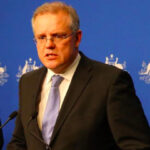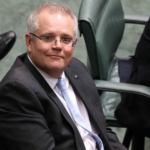Morrison and Murdoch Scrambled to Hide the Climate Cause of the Bushfires

Most Australians will remember that our supreme leader Scott Morrison disappeared for a Hawaiian holiday last summer as the nation grappled with bushfires on a scale that the government was unprepared for, despite long-term warnings coming from experts.
As Greenpeace’s Burnt Country report tells it, when Morrison did arrive back in Australia to assume his position as prime minister, he set about downplaying the role that climate change had in the unprecedented crisis.
The 2019/20 Black Summer bushfires burnt 20 percent of Australian mainland forest to the ground, over a billion animals were killed, thousands of homes were destroyed, and between 650 million and 1.2 billion tonnes of carbon emissions entered the atmosphere.
Released in mid-May, Burnt Country describes the coordinated tripartite campaign on the part of the Morrison government, the Murdoch press and the fossil fuel industry to plant seeds of doubt in the public sphere about global warming being the true cause behind the megafires.
However, the nationwide mass mobilisations demanding climate action that took place over the summer were an acknowledgement that rising numbers don’t buy the climate denying falsehoods being propagated by these forces.
Not fit for purpose
The Greenpeace report outlines three responses that came from the Morrison government in relation to the climate link to the massive blazes that took place over what turned into an almost nine month-long bushfire season.
The first response was the PM’s favourite chestnut, denial. Federal cabinet ministers were queueing up to reinforce that the fires were a natural part of this continent’s climate cycles.
And NSW deputy premier John Barilaro went as far as to call talk about climate change during the bushfires a “bloody disgrace”.
Unsurprisingly, as smoke coverage in cities and the accompanying wearing of facemasks became an everyday occurrence, demonstrations calling for an honest government approach to not only the fires, but their underlying cause began escalating with record numbers turning out.
“In response, the government changed tack,” the Greenpeace researchers outline. “Whilst it was no longer feasible to deny the role of climate change, the government instead began to minimise it, emphasising it was one of just many factors that led to the bushfires.”
The prime minister remarked just days before he snuck off to his Hawaiian retreat that the ongoing drought in the south east of the nation was the major factor behind the fires and that climate change was also a contributor.
However, he failed to note the climate link to the water shortage crisis.
Other factors leading to the bushfires that were cited by government included a lack of hazard reduction burning, too much fuel load remaining in national parks, restrictive land clearing laws and arson.
And the final position taken by the Morrison government was talk of adaptation. No longer was it denying changing climate as a cause of the fires, but rather it acknowledged it as something humans should adapt to, which in turn removed any impetus in regard to practically cutting emissions.
The fake news agenda
Australia’s largest media corporation News Corp was complicit in the spreading of falsehoods and fake news over the last summer. Murdoch’s company published 75 percent of articles denying a climate link to the bushfires, while it only published 46 percent of all articles on the fires and climate.
“News Corp consistently produced more articles attributing the bushfires to a lack of hazard reduction burning and arson than other” outlets, the report continues, adding that the evidence doesn’t point to arson, but rather lightning strikes and a dry landscape being the real culprits.
Indeed, News Corp’s sustained disinformation agenda sparked an even larger online social media campaign, #ArsonEmergency, which propagated the same lies.
According to the Greenpeace analysis, the arson emergency hashtag first appeared in a late November tweet. But its use really took off in the early days of January. And the researchers claim that this was in part due to a coordinated campaign to make it go viral.
A Queensland University of Technology study found there was an ongoing campaign that pushed the hashtag coming from 300 Twitter accounts, many of which turned out to be bots: fake accounts. And peaks in the use of the hashtag coincided with the publication of News Corp arson articles.
In its pocket
As for the fossil fuel industry’s actions during the crisis, it didn’t need to do much, as it had already carried out major groundwork running back decades that ensured the Australian government and the Murdoch media simply did its bidding.
The fossil fuel lobby has its tentacles extending all the way into the PM’s office. And the industry has long been able to use the nation’s laxed political donation laws, so it can simply buy the support of politicians, many of whom have, or later will, work amongst its ranks.
Greenpeace’s 2019 Dirty Power report exposed the way that fossil fuel players and News Corp insiders freely move back and forth between employment in their industries as well as key positions in federal government.
At present, Scott Morrison’s chief of staff is the former deputy CEO of the Minerals Council of Australia John Kunkel, while his senior advisor on international trade and investment is former Minerals Council CEO Brendan Pearson.
The prime minister’s speech writer Matthew Fynes-Clinton is the former editor and chief of staff of New Corp’s Courier Mail, and his press secretary, Andrew Carswell, is the former chief of staff of Murdoch’s Daily Telegraph.
Business as usual
The Burnt Country report also lists a number of fossil fuel projects that were greenlighted by various Australian governments between last December and March, while much of the country burned to the ground.
This included the approval of two new gas power plants – one in Queensland and the other in Victoria – permitting Shenhua to begin exploratory drilling for coal in northern NSW, and the opening up of 7,000 square kilometres of new land for coal, gas and oil exploration in Queensland.
And as the last fires were still ablaze in February, the PM appointed uranium-backing MP Keith Pitt to the position of resources minister. The Liberal Party member promptly set about announcing that his vision for the nation is more investment in coal, gas and uranium to lift standards of living.







